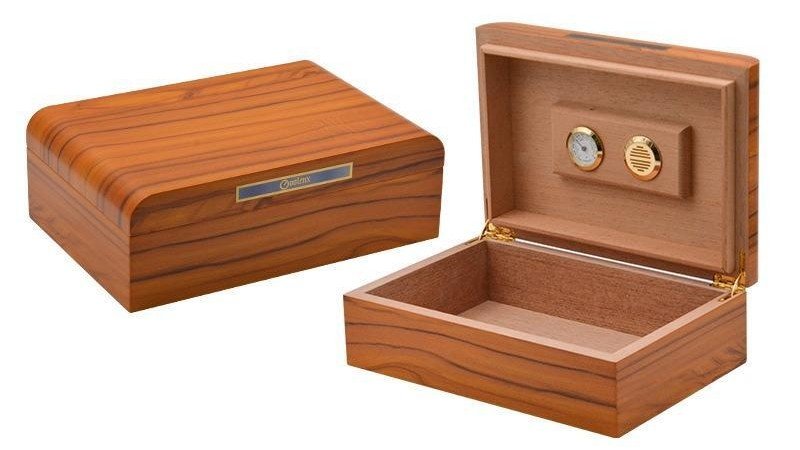
As a cigar box manufacturer with years of experience, I’ve seen firsthand how humidity control1 is one of the most critical factors in cigar preservation. A well-sealed cigar box ensures that cigars age properly, burn smoothly, and retain their rich flavors.
A cigar box maintains humidity by using moisture-regulating materials2, airtight seals, and precision-crafted joints that minimize air leakage. High-quality woods like Spanish cedar, combined with effective sealing techniques, create an environment where cigars can remain fresh and develop complex flavors over time.
In this article, I’ll break down how cigar boxes retain humidity, the best sealing methods, and how to maintain an effective moisture-controlled environment.
Why Is Proper Humidity Control Crucial for Cigars?
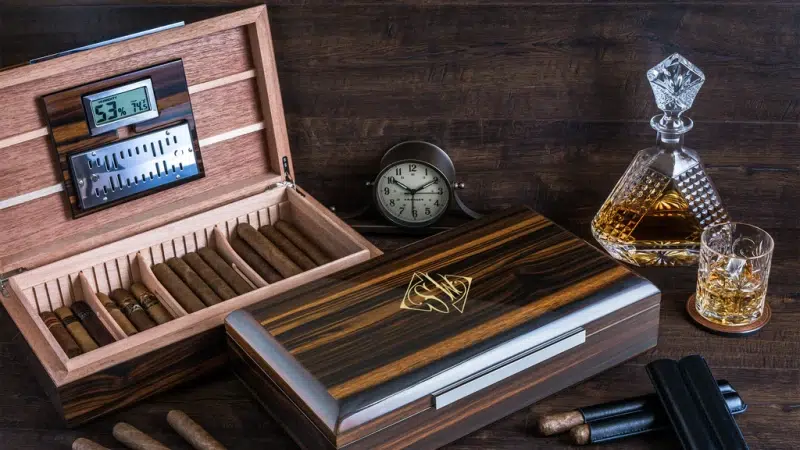
Cigars are hygroscopic, meaning they absorb and release moisture based on their surroundings. If the humidity inside a cigar box is too high, cigars can become moldy and difficult to smoke. If it’s too low, cigars dry out, crack, and lose their essential oils.
A cigar box must maintain a stable humidity level3 between 65-72% to preserve the cigar’s structure, aroma, and aging potential.
Effects of Humidity on Cigars
| Humidity Level | Impact on Cigars |
|---|---|
| Below 60% | Dry cigars, brittle wrappers, uneven burn. |
| 65-72% | Ideal range: cigars stay fresh, burn evenly, and age well. |
| Above 75% | Over-humidified cigars, tight draw, risk of mold. |
Maintaining the correct humidity ensures cigars remain perfectly conditioned for an enjoyable smoking experience.
What Are the Key Materials That Help Retain Humidity?
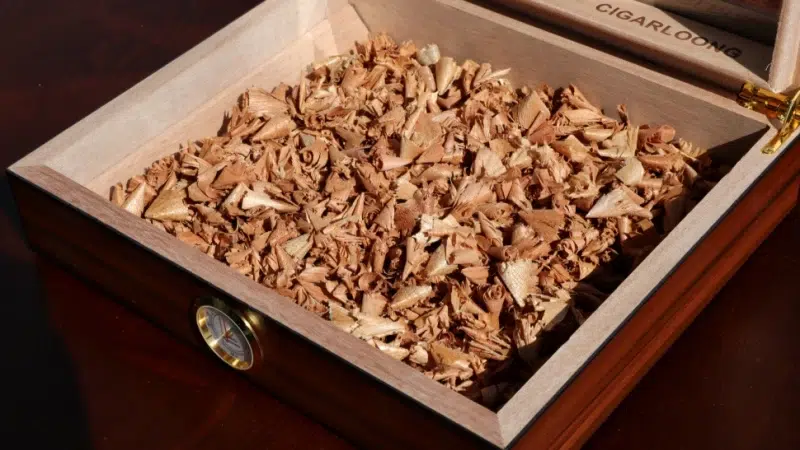
The type of wood used in a cigar box directly affects its ability to retain humidity. Some woods, like Spanish cedar, naturally absorb and release moisture to create a balanced environment. Others, like walnut or cherry, are chosen primarily for aesthetics and require additional humidity control systems4.
Spanish cedar is the most effective wood for maintaining humidity in cigar boxes because it regulates moisture levels, enhances cigar aging, and protects against tobacco beetles.
Comparison of Woods for Humidity Retention
| Tipo de madera | Humidity Retention | Additional Benefits |
|---|---|---|
| Cedro español | Excelente | Insect-resistant, enhances cigar aging. |
| Caoba | Bien | Stable, no excessive aroma. |
| Nogal | Bajo | Aesthetic appeal but requires a humidifier. |
| Roble | Bajo | Prone to absorbing flavors from cigars. |
A high-quality cigar box should be lined with Spanish cedar5 to provide consistent humidity control.
How Does the Box’s Seal Impact Humidity Retention?
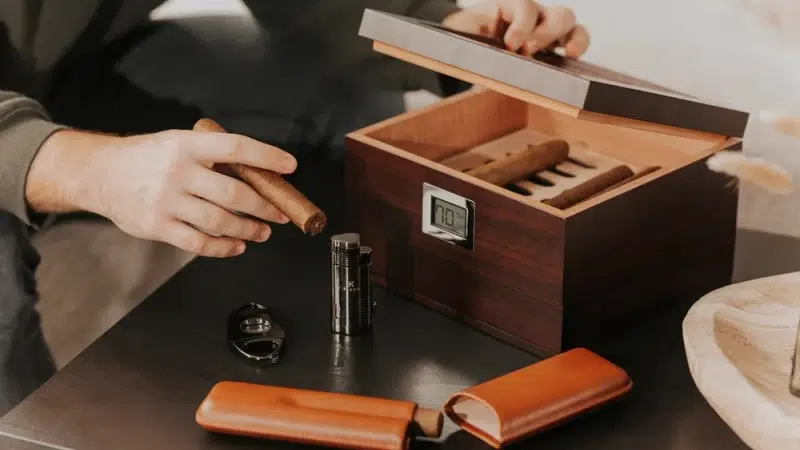
Even if a cigar box is made from the best moisture-regulating materials, it won’t hold humidity effectively without a proper seal.
The seal is crucial for minimizing air exchange, preventing moisture loss, and maintaining a stable internal humidity level.
Factors That Affect a Cigar Box’s Seal
- Lid Closure Mechanism – A well-fitted lid prevents air leaks.
- Seal Precision – Precision-cut joints reduce gaps where air can escape.
- Latching System – Magnetic closures or traditional locks help secure the seal.
A well-constructed cigar box should close smoothly with a soft "whoosh" sound, indicating a tight, air-resistant seal.
What Are the Most Effective Sealing Techniques for Cigar Boxes?
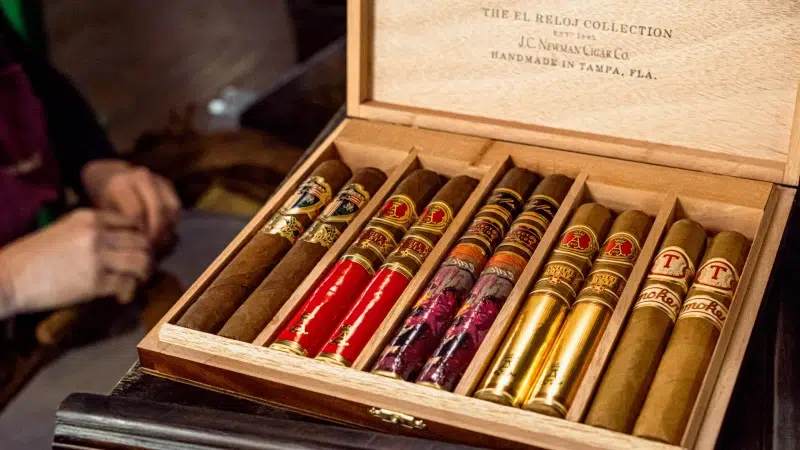
Cigar box manufacturers use various sealing techniques to enhance humidity retention. Some methods, like tongue-and-groove joints6, provide a natural airtight fit, while others, like rubberized seals7, are commonly found in high-end humidors.
The most effective sealing techniques for cigar boxes include tongue-and-groove joints, magnetic closures, and precisely milled lids that minimize air exchange.
Comparison of Sealing Techniques
| Sealing Method | How It Works | Effectiveness |
|---|---|---|
| Tongue-and-Groove Joints | Interlocking wood edges create a natural seal. | ★★★★★ |
| Magnetic Closures | Magnets ensure a snug lid fit. | ★★★★☆ |
| Rubberized Seals | Found in high-end humidors to create an airtight barrier. | ★★★★★ |
| Basic Hinged Lids | Simple design but may allow slight air leakage. | ★★★☆☆ |
For most premium cigar boxes, tongue-and-groove joints1 combined with magnetic closures8 offer an ideal balance of function and aesthetics.
Does a Humidifier System Inside the Box Make a Difference?

Even with the best sealing techniques, some cigar boxes require additional humidity control.
A built-in humidifier or humidity pack can help maintain consistent moisture levels, especially in environments with fluctuating humidity.
Types of Humidifiers Used in Cigar Boxes
| Humidifier Type | How It Works | Lo mejor para |
|---|---|---|
| Boveda Humidity Packs9 | Releases or absorbs moisture as needed. | Small to mid-size cigar boxes. |
| Sponge-Based Humidifiers | Absorbs water and releases humidity over time. | Traditional wooden humidors. |
| Electronic Humidifiers | Active humidity control for large humidors. | Large cigar cabinets. |
For standard wooden cigar boxes, using Boveda packs or sponge-based humidifiers is an effective way to stabilize humidity levels.
How Can You Test and Maintain Your Cigar Box’s Humidity Seal?

Even the best cigar box seals can weaken over time. Regular maintenance helps ensure that the box continues to hold humidity properly.
To maintain a cigar box’s humidity seal, regularly check for air leaks, test with a hygrometer10, and adjust humidity control methods as needed.
How to Test and Maintain a Cigar Box’s Humidity Seal
- Check the "Whoosh" Test – When closing the box, listen for a soft air escape sound.
- Use a Hygrometer – Place a digital hygrometer inside to monitor humidity levels over time.
- Inspect for Air Gaps – Run a thin strip of paper around the lid. If it moves freely, there’s an air leak.
- Recondition the Cedar Lining – Occasionally wipe the cedar interior with a damp cloth to maintain moisture absorption.
- Replace Humidity Packs or Humidifiers – Swap out Boveda packs or refill humidifiers as needed.
By keeping up with regular maintenance, your cigar box can provide optimal storage conditions for years to come.
Conclusión
A well-constructed cigar box plays a crucial role in humidity control. The combination of Spanish cedar lining, precision sealing techniques, and humidity-regulating accessories ensures cigars stay fresh, flavorful, and properly aged.
If you want the best storage for your cigars, look for a high-quality wooden cigar box with an airtight seal and proper humidity management.
Marca: WoodoBox
Eslogan: Cajas de madera personalizadas, hechas a la perfección
Página web: www.woodobox.com
-
Understanding humidity control is essential for preserving cigars' quality and flavor. Explore this link to learn more about its significance. ↩ ↩
-
Discover the types of moisture-regulating materials that enhance cigar preservation and ensure optimal aging. This knowledge is key for any cigar enthusiast. ↩
-
Learn about the ideal humidity levels for cigar storage to maintain their quality and flavor. This information is crucial for any serious cigar aficionado. ↩
-
Learn about various humidity control systems that can enhance the performance of cigar boxes, ensuring optimal conditions for cigars. ↩
-
Explore the unique properties of Spanish cedar that make it ideal for maintaining humidity in cigar boxes, enhancing cigar quality. ↩
-
Explore this link to understand how tongue-and-groove joints enhance the airtightness of cigar boxes, ensuring optimal humidity retention. ↩
-
Learn about rubberized seals and their importance in creating airtight barriers in premium humidors, crucial for cigar preservation. ↩
-
Discover the benefits of magnetic closures in cigar boxes, providing a snug fit that helps maintain humidity levels effectively. ↩
-
Explore this link to understand how Boveda packs can effectively maintain humidity levels in your cigar box, ensuring optimal storage conditions. ↩
-
Learn how to properly use a hygrometer to keep track of humidity levels, which is crucial for preserving your cigars' quality. ↩





